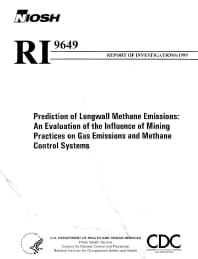Mining Publication: Prediction of Longwall Methane Emissions: An Evaluation of the Influence of Mining Practices on Gas Emissions and Methane Control Systems
Original creation date: October 1999
Authors: WP Diamond, F Garcia
NIOSHTIC2 Number: 20000193
Pittsburgh, PA: U.S. Department of Health and Human Services, Public Health Service, Centers for Disease Control and Prevention, NIOSH, DHHS (NIOSH) Publication No. 99-150, Report of Investigations 9649, NTIS No. PB 20000-101707, 1999 Oct: ;1-32
As part of its mine safety and health research program, the National Institute for Occupational Safety and Health, Pittsburgh Research Laboratory, has been investigating the geologic and mining factors influencing methane gas emissions associated with longwall mining. A primary focus of this research has been the consequences of increasing longwall panel dimensions, particularly face width, in gassy coalbeds. Continuous longwall face emission monitoring studies were conducted at two adjacent mines operating in the Pocahontas No. 3 Coalbed, where longwall faces were to be extended from 229 to 305 m (750 to 1,000 ft). Average longwall pass methane emission rates for 229-m (750-ft) wide faces were 61 % (0.072 m3/sec (153 cfm)) higher at the VP-3 Mine than at the VP-1 Mine. It was predicted by regression analysis of methane emissions data from 229-m (750-ft) wide faces that extending faces to 305 m (1,000 ft) would increase methane emission rates by only 7%, or 0.009 m3/sec (20 cfm), to 0.144 m3/sec (304 cfm) at the VP-1 Mine. In contrast, it was predicted that extending faces to 305 m (1,000 ft) at the VP-3 Mine would increase methane emissions by as much as 13%, or 0.029 m3/sec (65 cfm), to 0.268 m3/sec (567 cfm).

NIOSHTIC2 Number: 20000193
Pittsburgh, PA: U.S. Department of Health and Human Services, Public Health Service, Centers for Disease Control and Prevention, NIOSH, DHHS (NIOSH) Publication No. 99-150, Report of Investigations 9649, NTIS No. PB 20000-101707, 1999 Oct: ;1-32